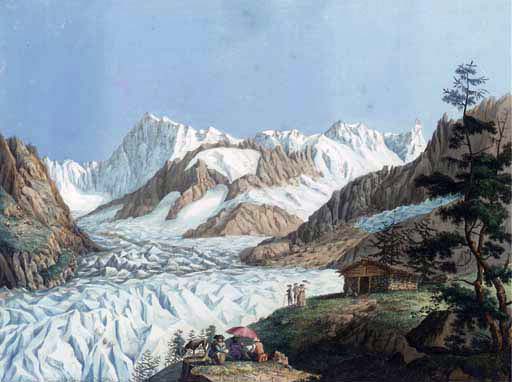”
“The most desolate place in the world” where Mary Shelley thought she was overlooking the Mer de Glace, Sea of Ice, grinding into the Chamonix valley.
Her descriptive phrase suggests that she and her traveling companions, Percy Shelley (her lover) and Claire Clairmont (her half-sister), were in peril. They were not. On July 24, 1816, they ascended on horseback accompanied by a guide to an altitude of 6000 feet, where they settled on a plateau overlooking the glacier for a picnic lunch on the grass in cold air. In her journal, Mary laconically states, “We dine on the mountain–the air is very cold, yet many flowers grow here & among other the rhododendron or Rose des Alps in great profusion—We descend leisurely.” In A History of a Six Weeks’ Tour (1817), a travelogue, Percy and Mary describe the “Lines of dazzling ice occupy here and there their perpendicular rifts, and shine through the driving vapours with inexpressible brilliance: they pierce the clouds like things not belonging to this earth.” They were deeply affected and incorporated the scenery elsewhere; he into “Mont Blanc” (1817), and she into Frankenstein, or The Modern Prometheus (1818). Neither work is picnicky and without reference to alfresco dining. Percy describes the excitement of the alpine scene’s tumult and chaos. Mary writes that Victor recalls the view from the mountain as sublime. “I remembered,” Victor says, ” the effect that the view of the tremendous and ever-moving glacier had produced upon my mind when I first saw it. It had then filled me with a sublime ecstasy that gave wings to the soul and allowed it to soar from the obscure world to light and joy. The sight of the awful and majestic in nature had indeed always the effect of solemnising my mind and causing me to forget the passing cares of life. I determined to go without a guide, for I was well acquainted with the path, and the presence of another would destroy the solitary grandeur of the scene.” Not long after, Victor and his Creature meet and find shelter in a hut where the Creature tells his story.
Fortunately for literature, Mary and Percy were there on a miserable day in July. Had it been sunny, the atmosphere would have been less desolate; the glacier’s sublimity might not have so negatively charged them. Carl Ludwig Hackert’s View of the Sea of Ice [Mer de Glace] (1781) shows a group of picnickers relaxing under an umbrella as they view the sublime scenery at ease in safety. On a sunny August day, sightseers lounge with packed lunches or purchased refreshments at Blair’s pavilion, the slab-sided building on the knoll right. When Mary and Shelley visited, the pavilion had been improved and dedicated as a temple of nature, La Temple de la nature.
It is unknown what they carried up the mountain for their picnic. Percy was an ardent vegetarian, and Mary probably agreed with his food choices. The Creature is a vegetarian, living off the land nourished by eating berries, nuts, and acorns. James Whale’s 1931 film doesn’t hint at a picnic. The scene (obviously a film production studio) shows Frankenstein and the Creature on the mountain, standing about six feet apart, separated by tense hostility.
Featured Image: Carl Ludwig Hackert. View of the Sea of Ice at the Summit of Montanvert and Blair’s Pavilion in the month of August 1781 [Vue de la mer de glace et de l’Hospital de Blair du somet du Montanvert dans le mois d’Aoust 1781]
See Mary Wollstonecraft Shelley, The Journals of Mary Shelley 1814–1844, ed. by Paula R. Feldman and Diana Scott-Kilvert, 2 vols. Oxford: Clarendon Press, 1987; Mary Shelley. Frankenstein, or The Modern Prometheus. London: Lackington, Hughes, Hading, Mavor & Jones, 1818; Percy Shelley and Mary Shelley. “Letter IV: St. Martin-Servoz-Montanvert-Chamouni-Mont Blanc.” In History of a Six Weeks’ Tour through a Part of France, Switzerland, Germany, and Holland with Letters Descriptive of a Sail Round the Lake of Geneva, and the Glaciers of Chamouni. London: T. Hookham and C. and J. Ollier, 1817; Patrick Vincent. “Le Temple de la Nature, Chamonix.” https://www.euromanticism.org/le-temple-de-la-nature-chamonix/

